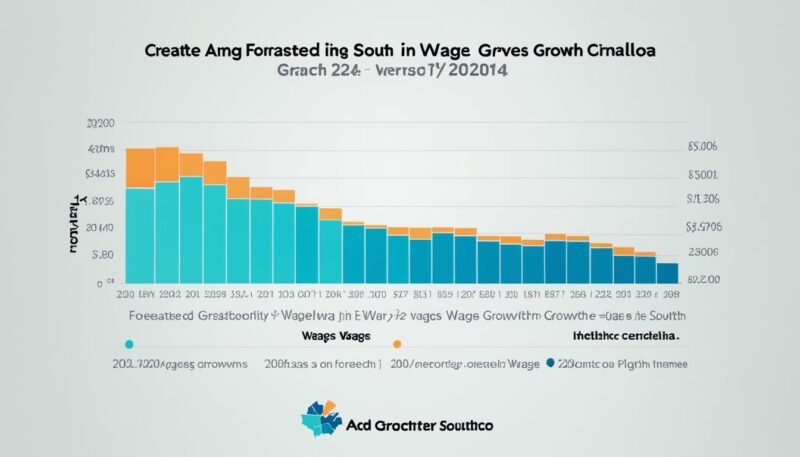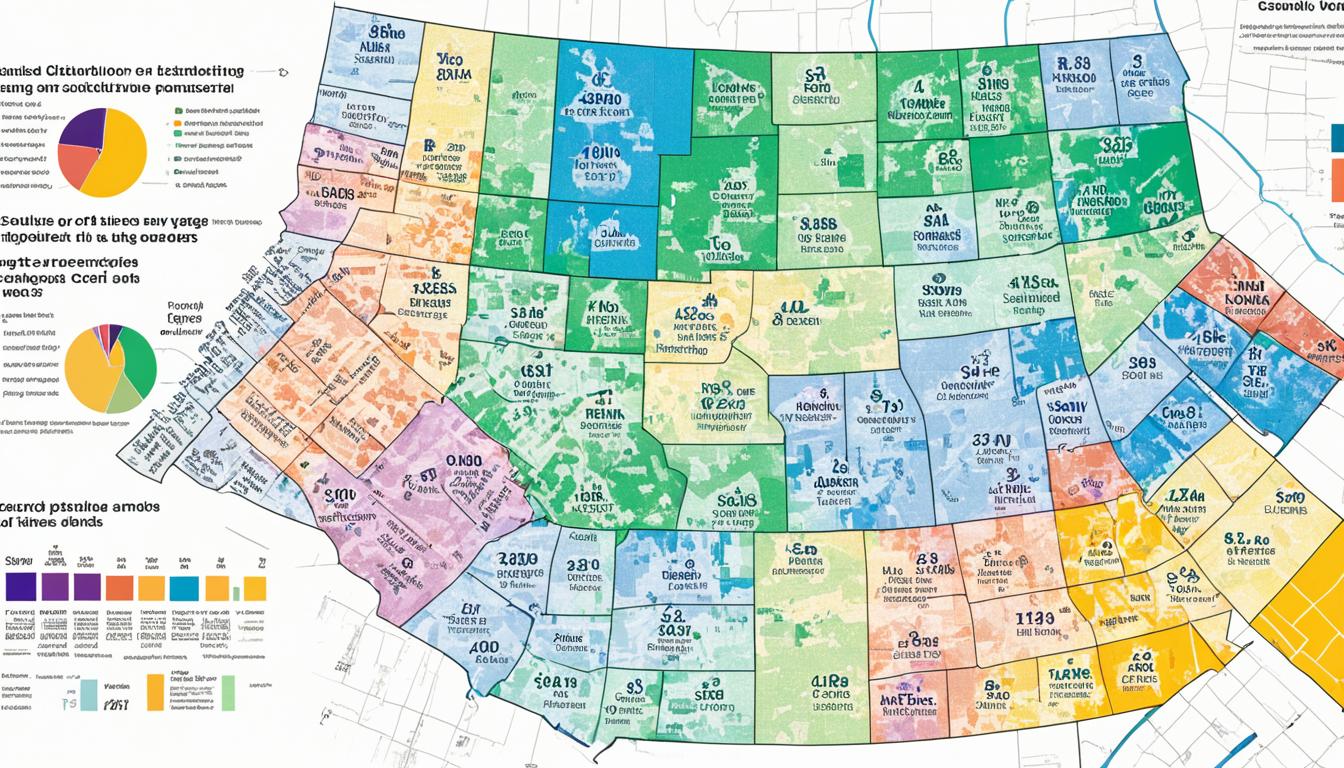As we advance into the year 2024, understanding the landscape of employment wages in South Carolina becomes crucial for job seekers, employers, and economic strategists alike. In an effort to provide a thorough insight into this subject, we examine the South Carolina salary statistics 2024, illuminating the factors influencing income rates across the state.
This exploration is more than a mere snapshot of the present; it is a compass pointing towards future opportunities and challenges within the labor market. For those navigating the complex terrain of wages in South Carolina 2024, our detailed report serves as an indispensable guide, offering clarity and perspective on the ebbs and flows of the state’s economic heartbeat.
Key Takeaways
- Insightful breakdown of South Carolina salary statistics 2024, vital for market predictions and financial planning.
- Comprehensive review of employment wages in South Carolina, including comparative regional analysis.
- Critical examination of the socioeconomic trends significantly impacting wages in South Carolina 2024.
- Engagement with historical data trends to forecast future wage patterns in the South Carolina job market.
- Essential information for policymakers to formulate strategies aligning with wage trends and economic growth.
Overview of Wages in South Carolina 2024
As we examine the South Carolina wage trends in 2024, it’s evident that the state’s economic momentum has influenced income levels in South Carolina. The ongoing growth reflects a diverse and dynamic job market. With various sectors flourishing, professionals across the state are witnessing changes in compensation reflective of broader economic currents.
This broad perspective on wage conditions reveals that salary figures in the state show positive increments, which can be attributed to competitive market forces and burgeoning industries settling in South Carolina’s favorable economic climate. At the same time, this growth is also framed by the cost of living considerations that impact the real income of the residents across different regions. Notably, the state’s capital, Columbia, along with Charleston’s vibrant urban center, leads in wage scales compared to rural areas, underscoring the geographic salary variances within the state.
When positioning South Carolina’s income levels within the national landscape, data indicates that the state’s wages are advancing at a commendable pace. However, they remain distinct from the flashpoints of economic activity that characterize the wage climate in tech-heavy or finance-dominated states. This disparity illustrates the importance of local economic development strategies focused on enhancing South Carolina’s competitive edge to attract high-wage industries.
According to recent reports, South Carolina’s average wages continue to experience upward movement, which professionals and businesses alike must consider when navigating the job market.
To further detail the wage trends, here’s an overview reflective of the South Carolina job market in 2024:
- Consistent wage increases across technology and healthcare sectors.
- Heightened demand for skilled labor has prompted competitive wage offerings.
- Increased minimum wage has uplifted entry-level income rates.
- Continued investment in education and workforce development to adapt to evolving industry standards.
The overall wage scenario in South Carolina presents a promising outlook for professionals. Yet, it also highlights the necessity for ongoing adaptation and advancement to meet the demands of a rapidly changing economic environment.
South Carolina Wage Trends in Recent Years
Analyzing South Carolina’s (SC) labor market reveals significant trends that shape the state’s economic landscape. Particularly noteworthy has been the SC wage growth forecast which predicts shifts based on industry demand, technological advancements, and policy changes. This section draws on historical data to understand these movements and provide context for average wages by industry SC 2024.

Prior to 2024, the state experienced varying rates of wage increases, influenced by sectors such as manufacturing, healthcare, and technology. To illustrate these variances, we look at average wages across multiple industries. The hospitality industry, for example, saw modest increases, while tech sectors outpaced others substantially. Below is a comprehensive comparison of the average wages by industry in recent years in South Carolina:
| Industry | Average Wage 2021 | Average Wage 2022 | Average Wage 2023 |
|---|---|---|---|
| Technology | $85,000 | $90,000 | $95,000 |
| Healthcare | $65,000 | $68,000 | $70,000 |
| Manufacturing | $55,000 | $57,000 | $60,000 |
| Hospitality | $30,000 | $31,000 | $32,000 |
Economic events, such as the introduction of new technologies and an influx of foreign investment, particularly into the tech industry, contributed significantly to wage growth. Indeed, policy changes like tax incentives for businesses have also played their part in bolstering wages, especially in specialized sectors.
As the Bureau of Labor Statistics reports confirm, the wage increase trajectory has altered the job market, making SC an emerging competitor for skilled labor.
In conclusion, the data affirms that understanding past wage trends is vital in forecasting future growth. With industry-specific analyses, stakeholders can discern the direction in which different sectors are moving and, in turn, predict the average wages in SC for the year 2024.
Analyzing Average Wages by Industry in SC 2024
The economic tapestry of South Carolina is diverse, with each industry contributing to the larger picture of state wage trends. In 2024, the average wages by industry in South Carolina reflect both the strengths and challenges faced by different industry sectors. Employment wages in South Carolina vary significantly, underlining the importance of industry-specific analysis.
High-Growth Industries and Their Wage Scales
Industries such as Information Technology, Healthcare, and Advanced Manufacturing are showing promising growth in South Carolina. The influx of technological innovations and a growing population have led to increased wage scales in sectors associated with high skill demands. Let’s look at the following data to provide context:
| Industry | Average Annual Wage |
|---|---|
| Information Technology | $85,000 |
| Healthcare & Social Assistance | $65,000 |
| Advanced Manufacturing | $60,000 |
Stagnant or Declining Industries
In contrast, industries such as Textiles and Agriculture have not shared this upward wage trajectory. Global competition and automation have subdued wage growth in these sectors. The following table sheds light on the average wage figures within these stagnant or declining industries:
| Industry | Average Annual Wage |
|---|---|
| Textiles | $35,000 |
| Agriculture and Forestry | $30,000 |
South Carolina’s economy is a reflection of this intricate mix of industries, with various factors driving wage rates. It’s imperative for stakeholders to understand these differences and adjust their strategies accordingly to support sustainable wage growth across all industry sectors.
Employment Wages in South Carolina: The Minimum Wage Law Factor
In the ongoing dialogue about financial stability and labor rights, the minimum wage law in South Carolina emerges as a pivotal influence on employment wages. South Carolina’s legislative landscape has set standards that directly impact household income and the economic health of working-class citizens. Addressing the minimum wage is not just a question of legal compliance; it also reflects the state’s commitment to ensuring fair compensation for labor.
The current framework surrounding the South Carolina salary statistics 2024 demonstrates a complex interplay between employer prerogatives and employee livelihoods. It’s crucial to understand how minimum wage statutes shape the remuneration across various employment sectors, especially when considering the income floor for entry-level roles. The reach of these laws is seen in the contrast between living expenses and the legal minimum employers are obliged to pay.
“The State encourages responsible business practices that uphold not only the minima mandated by law but also the need for a wage that meets the rising cost of living.” – South Carolina Department of Labor
On one hand, the minimum wage law serves as a tool designed to protect workers from unduly low pay. On the other, it may also influence the competitive stance of South Carolina in the national labor market. Attracting industries to the state hinges on a complex balance of workforce skill levels, wage expectations, and business-friendly policies. However, the enduring question remains, to what extent are these regulations fostering economic mobility and job market fluidity?
- Analysis of entry-level wages in relation to the minimum wage law
- The effect of current minimum wage standards on overall income levels
- Correlation between minimum wage policies and state industry attractiveness
In assessing the effects of minimum wage law, it’s not enough to review statutory provisions in isolation. It’s imperative to consider the broader economic context, as well as the tangible experiences of those who live on these legislated earnings. Such evaluations must also take into key considerations the way minimum wage benchmarks act as a threshold for increases in salaries for seasoned workers as well.
The examination of South Carolina salary statistics 2024 gives policymakers, employers, and workers alike the insights needed to navigate the evolving terrain of fair wage discussions, thus shaping an economy that aspires to balance competitive enterprise with worker wellbeing.
Conclusion
As we’ve navigated through the various aspects of wages in South Carolina for 2024, we’ve assembled a picture marked by nuanced industry shifts and regulatory impacts. This comprehensive examination has shed light on the regional economic patterns, revealing both promising developments and areas demanding attention. Income levels in South Carolina, reflective of the dynamic wage landscape, are key to the state’s economic trajectory. With the analysis of historical data, current statistics, and industry-specific wage scales, a multi-faceted understanding of South Carolina’s salary figures emerges, providing valuable insights for stakeholders.
The State of Income Levels in South Carolina 2024
The revelation of income levels in South Carolina for 2024 conveys an economy experiencing varied growth across sectors. Certain high-growth industries have been seen to propel wage increases, lifting the overall income levels, while others maintain a more modest pace. The minimum wage laws, alongside market forces, play a substantial role in shaping the financial prospects for the state’s workforce. The synthesis of South Carolina salary statistics for 2024 offers key indicators for economic health and serves as a benchmark for future wage assessments.
Forecasting SC Wage Growth: Looking Beyond 2024
Peering into the horizon beyond 2024, the SC wage growth forecast indicates a continued evolution influenced by numerous economic factors, industry advancements, and potential legislative adjustments. Anticipated trends suggest that sectors embracing innovation and technological integration may offer greater wage growth potential. Proactive policy initiatives could further steer wage trends in a direction that promotes sustainable growth and economic resilience. Keeping a close watch on these developments will be crucial for predicting how the landscape of wages in South Carolina might contour in the years to come.
